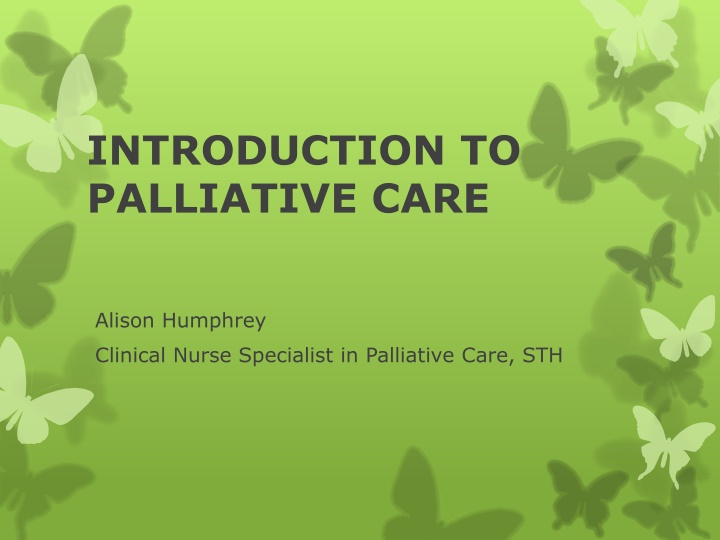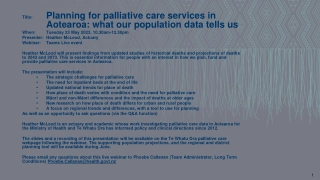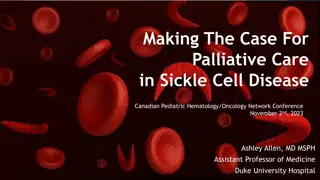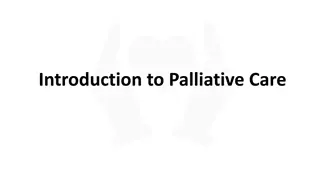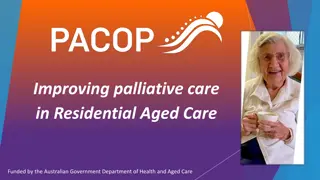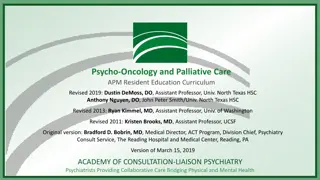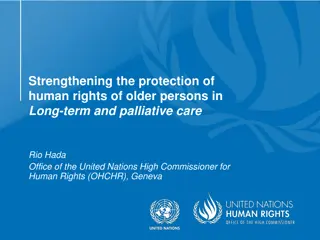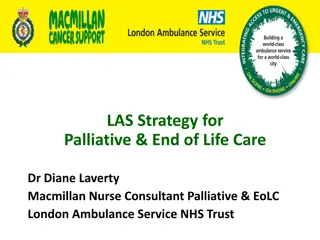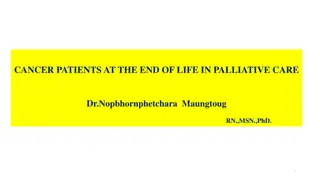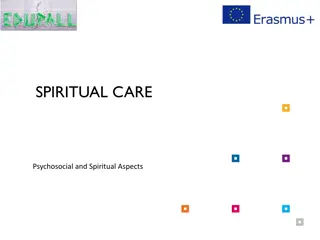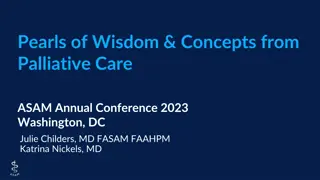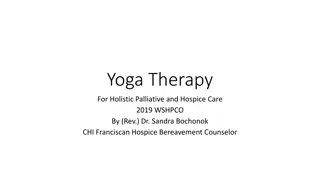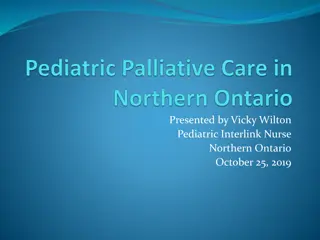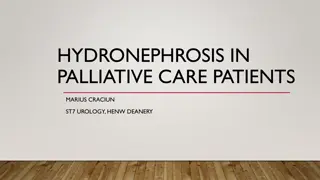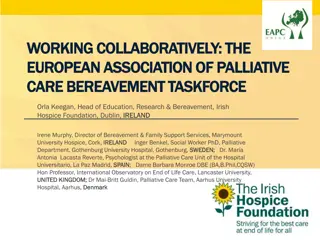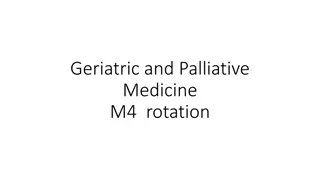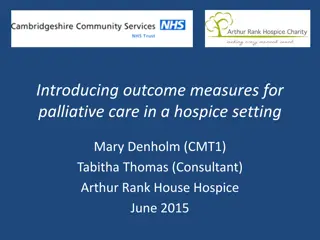Overview of Palliative Care: History, Definition, and Aims
Explore the rich history and development of palliative care from ancient times to modern practices. Learn about the aims of palliative care, including improving quality of life for patients facing life-threatening illnesses. Discover the holistic approach of palliative care and the importance of supportive care for patients and their families throughout their journey. Understand the significance of end-of-life care strategies in helping patients live well until the end and supporting their loved ones through bereavement.
Download Presentation

Please find below an Image/Link to download the presentation.
The content on the website is provided AS IS for your information and personal use only. It may not be sold, licensed, or shared on other websites without obtaining consent from the author.If you encounter any issues during the download, it is possible that the publisher has removed the file from their server.
You are allowed to download the files provided on this website for personal or commercial use, subject to the condition that they are used lawfully. All files are the property of their respective owners.
The content on the website is provided AS IS for your information and personal use only. It may not be sold, licensed, or shared on other websites without obtaining consent from the author.
E N D
Presentation Transcript
INTRODUCTION TO PALLIATIVE CARE Alison Humphrey Clinical Nurse Specialist in Palliative Care, STH
AIMS To explore development of Palliative Care Definitions Where are we now Service available and how to access them
HISTORY OF HOSPICE/PALLIATIVE CARE END OF LIFE CARE PALLIATIVE CARE SUPPORTIVE CARE MODERN HOSPICE CARE Influenced by Ciceley Saunders Separation 1945-1965 Transition 1965-1985 Incorporation 1985 - present HISTORY OF HOSPICE Existed in Roman Times Charitable institutions for travellers 19th century religious influence and opened for care of the dying
PALLIATIVE CARE PALLIATIVE CARE END OF LIFE CARE SUPPORTIVE CARE
PALLIATIVE CARE Palliative care is an approach that improves the quality of life of patients and their families facing the problems associated with life-threatening illness, through prevention and relief of suffering by means of early identification and impeccable assessment and treatment of pain and other problems physical, psychosocial and spiritual (WHO, 2002) Palliative Care should involve holistic care according to NICE (2004) striving for best quality of life , applicable earlier in the course of the illness in conjunction with other treatments and to help patients to live as actively as possible until death and to help the family to cope during the patient s illness and in their own bereavement (p.20).
SUPPORTIVE CARE The emphasis of supportive care is to support patients and families during treatment and allowing them to live as well as possible with the effects of the disease (NICE, 2004 p.18) and even mentions from diagnosis through to cure as well as to death and bereavement. This would fit with the cancer survivorship, initiative (DOH, 2007a, 2010); a cancer survivor being : someone who has completed initial treatment and has no apparent evidence of active disease, or is living with progressive disease and may be receiving treatment but is not in the terminal phase of illness, or someone who has had cancer in the past (Corner, 2007). Long Term Conditions
END OF LIFE CARE End of Life Care Strategy (2008) has the aim of allowing patients to live as well until they die throughout the last phase of life and into bereavement . The last phase considered to be last 12 months of life. Advanced Care Planning Amber Bundles
EMPHASIS ON END OF LIFE CARE One in 10 patients die during their hospital stay Chris Smyth The Times Published: 19 March 2014 Liverpool care pathway review shows challenges in palliative care Melanie Henwood Guardian Professional, Tuesday 23 July 2013 Neuberger Report, 2013 Francis Report, 2013
GENERAL PALLIATIVE CARE General palliative careis the level of palliative care which should be provided by all healthcare professionals, in primary or secondary care, within their duties to patients with life-limiting disease
SPECIALIST PALLIATIVE CARE Holistic and multidisciplinary approach MDT consist of Doctors, Nurses, Social Worker, Therapists, Chaplain, Complementary Therapies Provided at the expert level, by a trained, multi- professional team in order to manage persisting, sever or complex problems
REFERRAL CRITERIA UUncontrolled Complex Symptoms Complex Social Issues End of Life care Psychological Emotional Issues Related to illness Psychospiritual Issues
REFERRALS NOT MEETING CRITERIA Condition inactive and stable Respite Chroni c Pain Palliative Package of care Long term care
SERVICES AVAILABLE IN STH Hospital Support Team consisting of Consultant, Registrar and Clinical Nurse Specialists Macmillan Palliative Care Unit 18 bedded inpatient unit Outpatient clinics run by Consultants and Registrars Community Visits Complex Case Management
COMMUNITY TEAM SERVICES IN SHEFFIELD Community Specialist Palliative Care Team consisting mainly of Clinical Nurse Specialists with access to Consultant and Registrar Support St Luke s Hospice Inpatient Centre 20 bedded unit Therapies and Rehabilitation Centre Day Care
OUT OF HOURS Community Contact St Luke s main switchboard. STH Palliative Care CNS Team providing seven day, 9-5 service STH after 5pm Contact switchboard who will contact Registrar on call for Palliative Care
HOW TO REFER Complete referral form with as much detail as possible and urgency Fax to appropriate number Send additional information if felt needed
HOW REFERRAL IS PROCESSED FOR COMMUNITY SERVICES AND INPATIENT UNIT Discussion at Daily Referral Meeting If not accepted, reasons given If accepted, allocated to requested service Referring Professional contacted Contact made with patient
REFERRAL TO HOSPITAL SUPPORT TEAM Referrals reviewed by Palliative Care CNS Referrals prioritised Visit ward
REFERENCES CORNER, Jessica (2007) Making the National Cancer Survivorship Initiative a Reality powerpoint presentation at Britain against Cancer Conference London http://www.macmillan.org.uk/Documents/GetInvolved/Campaigns/Campaigns/APPG/b rita accessed DEPARTMENT OF HEALTH, MACMILLAN CANCER SUPORT AND NHS IMPROVEMENT (2010) National Cancer Survivorship Initiative (NCSI) Vision. London, Crown DEPARTMENT OF HEALTH (2008) End of Life Care Strategy - Promoting high quality care for all adults at the end of life. London, Crown DEPARTMENT OF HEALTH (2013)MORE CARE,LESS PATHWAY A REVIEW OF THE LIVERPOOL CARE PATHWAY NATIONAL INSTITUTE FOR CLINICAL EXCELLENCE (2004) Improving Supportive and Palliative Care for Adults with Cancer London, National Institute for Clinical Excellence Report of the Mid Staffordshire NHS Foundation Trust Public Inquiry www.midstaffspublicinquiry.com The AMBER Care Bundle Design Team (2011) www.ambercarebundle.org WORLD HEALTH ORGANISATION (2002) WHO Definition of Palliative Care http://www.who.int/cancer/palliative/definition/en/
